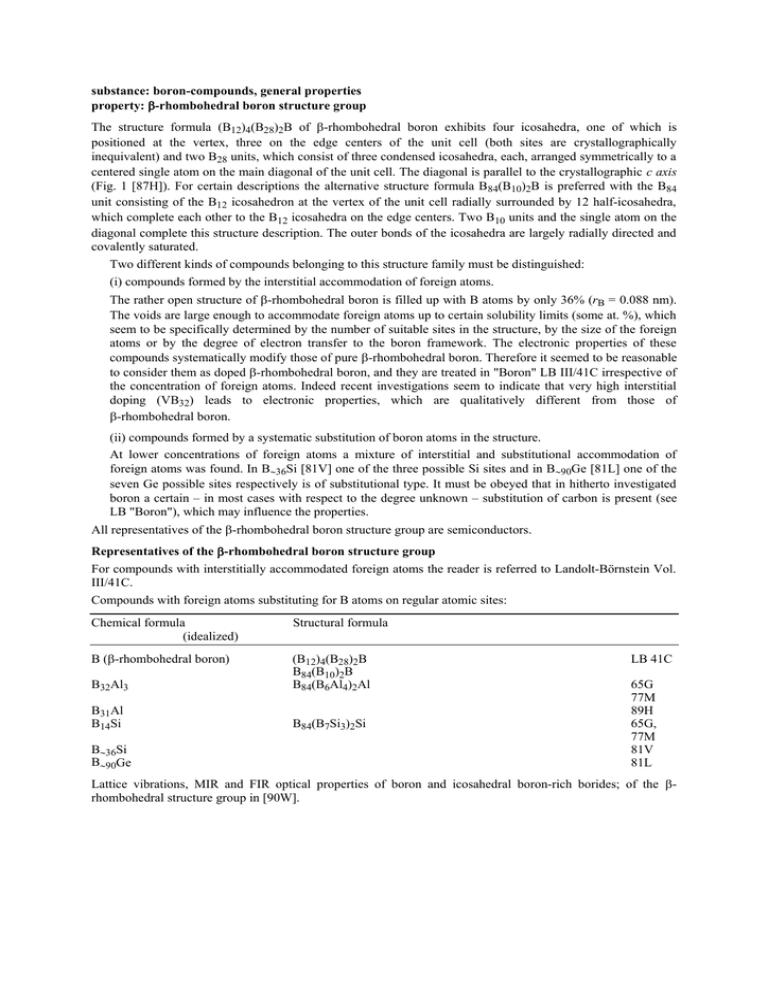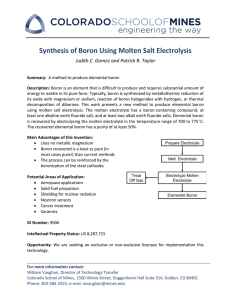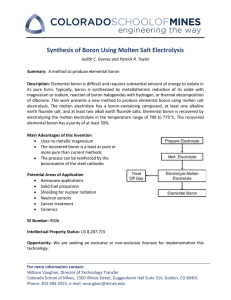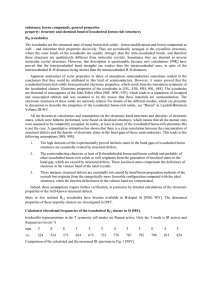substance: boron-compounds, general properties property: -rhombohedral boron structure group β
advertisement

substance: boron-compounds, general properties property: β-rhombohedral boron structure group The structure formula (B12)4(B28)2B of β-rhombohedral boron exhibits four icosahedra, one of which is positioned at the vertex, three on the edge centers of the unit cell (both sites are crystallographically inequivalent) and two B28 units, which consist of three condensed icosahedra, each, arranged symmetrically to a centered single atom on the main diagonal of the unit cell. The diagonal is parallel to the crystallographic c axis (Fig. 1 [87H]). For certain descriptions the alternative structure formula B84(B10)2B is preferred with the B84 unit consisting of the B12 icosahedron at the vertex of the unit cell radially surrounded by 12 half-icosahedra, which complete each other to the B12 icosahedra on the edge centers. Two B10 units and the single atom on the diagonal complete this structure description. The outer bonds of the icosahedra are largely radially directed and covalently saturated. Two different kinds of compounds belonging to this structure family must be distinguished: (i) compounds formed by the interstitial accommodation of foreign atoms. The rather open structure of β-rhombohedral boron is filled up with B atoms by only 36% (rB = 0.088 nm). The voids are large enough to accommodate foreign atoms up to certain solubility limits (some at. %), which seem to be specifically determined by the number of suitable sites in the structure, by the size of the foreign atoms or by the degree of electron transfer to the boron framework. The electronic properties of these compounds systematically modify those of pure β-rhombohedral boron. Therefore it seemed to be reasonable to consider them as doped β-rhombohedral boron, and they are treated in "Boron" LB III/41C irrespective of the concentration of foreign atoms. Indeed recent investigations seem to indicate that very high interstitial doping (VB32) leads to electronic properties, which are qualitatively different from those of β-rhombohedral boron. (ii) compounds formed by a systematic substitution of boron atoms in the structure. At lower concentrations of foreign atoms a mixture of interstitial and substitutional accommodation of foreign atoms was found. In B∼36Si [81V] one of the three possible Si sites and in B∼90Ge [81L] one of the seven Ge possible sites respectively is of substitutional type. It must be obeyed that in hitherto investigated boron a certain – in most cases with respect to the degree unknown – substitution of carbon is present (see LB "Boron"), which may influence the properties. All representatives of the β-rhombohedral boron structure group are semiconductors. Representatives of the β-rhombohedral boron structure group For compounds with interstitially accommodated foreign atoms the reader is referred to Landolt-Börnstein Vol. III/41C. Compounds with foreign atoms substituting for B atoms on regular atomic sites: Chemical formula (idealized) Structural formula B (β-rhombohedral boron) B32Al3 (B12)4(B28)2B B84(B10)2B B84(B6Al4)2Al B31Al B14Si B84(B7Si3)2Si B∼36Si B∼90Ge LB 41C 65G 77M 89H 65G, 77M 81V 81L Lattice vibrations, MIR and FIR optical properties of boron and icosahedral boron-rich borides; of the βrhombohedral structure group in [90W]. References: 65G 77M 81L 81V 87H 89H 90W Giese, R.F. Jr., Economy, J., Matkovich, V.I.: Z. Kristallogr. 122 (1965) 144. Matkovich, V.I., Economy, J.: in: Boron and Refractory Borides, V.I. Matkovich ed., Springer: Berlin, Heidelberg, New York, 1977, p. 96. Lejay, P., Chevalier, B., Etourneau, J., Hagenmuller, P:: J. Less-Common Met. 82 (1981) 193. Vlasse, M., Viala, J.C.: J. Solid State Chem. 37 (1981) 181. Higashi, I., Ito, T.: in: Proc. 9th Int. Symp. Boron, Borides and Rel. Compounds, University of Duisburg, Germany, Sept. 21 - 25, 1987, H. Werheit ed., University of Duisburg: Duisburg, 1987, p. 41. Higashi, I., Iwasaki, H., Ito, T., Lundström, T., Okada, S., Tergenius, L.-E.: J. Solid State Chem. 82 (1989) 230. Werheit, H., Haupt, H., Lundström, T., Higashi, I.: Z. Naturforsch. 45a (1990) 1016. Fig. 1. β-rhombohedral boron structure group. (a) Basic structural layer of B12 icosahedra in β-rhombohedral boron as projected on the (111) plane. There are threefold inversion axes through the center of 4 B 12 icosahedra in parallel with the [111] direction. (b) Features of the linkages between a B28 unit and B12 icosahedra [87H]. β-rh B structure group a b




